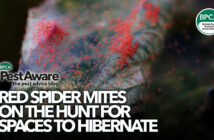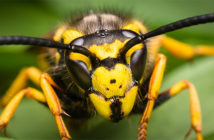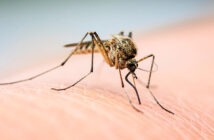In our report from the SX Environmental Supplies open day in Barnsley last week, David Askey of North West Pest Control asked for advice in identifying what species the small white tailed bumblebees he had come across might be. Barry Philips from SX contacted us with the some excellent information and advice as follows:
In the UK there are 24 species of bumblebee but only eight are commonly found in most places.
The two main bumble bees that fit the description of having white tips to their abdomen are either,
‘White Tailed Bumblebee’ ( Bombus lucorum ) or the Tree Bumblebee ( Bombus hypnorum )
The White Tailed Bumblebee, is more common and is widespread throughout the UK, though their numbers are reported to be in decline. The queens, which are first to emerge in spring, have a distinct white tip to their abdomen. Males follow in numbers late summer, around the end of July/start of August.
Due to the high volume of calls received at SX from our customers over the past few months, I would put my money on these actually being the Tree Bumble. This bee has been around in the UK for over 13 years and has steadily become established, mainly in the South East.
The Tree Bumblebee
Though both bees are similar in that they have a white tip. The Tree Bumblebee has other distinct characteristics that should make it easy to identify. Queens, workers and males all have black heads, and a very distinct gingery coloured thorax, a black or very dark abdomen and a white ‘tail’ (abdomen tip)
This year the reported sightings of the Tree Bumblebee have risen at a rapid rate. Sightings from Falmouth in the South to areas as far North as Inverness. We are taking calls on a daily basis from professionals requesting identification and advice on bees, with over 90 % being confirmed as Tree Bumbles.
With popular nest locations being, tree holes, in and around eaves of roofs and even bird boxes.
There are many conflicting reports, especially on the internet, of these bees being a risk to our more established indigenous bees, however most respected experts dismiss this as unproven. There are several organisations that compile ongoing surveys to map sightings of these bees and other species across the UK. These offer a great resource to pest controllers and I’m sure they would welcome your future sightings to assist their research. One in particular, the Open Air Laboratories (OPAL) network is run by The Imperial College of London in partnership with other renowned organisations.
The advice for dealing with this bee is the same as with all bumble bees. Try to educate and advise the customer of the limited risks to them from stings etc. Employ the services of a reputable bee keeper to remove. But if all else fails, and the client is adamant, then you can dispatch the nest using a suitable insecticide. Contrary to popular myth, it is not illegal to kill bees. However, inappropriate use of insecticides in the wrong environments, where there are risks to non-target species, including honey bees or other animals, can result in legal action and heavy fines. If in doubt always seek advice from your supplier.
Due to the volume of bees nests this season, many bee keepers are having to turn work down and are just not available. This has resulted in some pest controllers moving the nests themselves, rather than killing the bees. This is commendable and helps dispel the unfair but very common belief, that all we pest controllers do is kill everything that moves. However if you do move a nest please follow the advice detailed berlow which comes courtesy of the Bumblebee Conservation Trust:
-
Bumblebees are less likely to sting than honeybees and wasps. However, disturbing the nest can make them behave defensively and precautions should be taken to prevent stings occurring. While a full bee-keepers’ suit is helpful, it is not necessary. As a minimum, a person moving a nest should wear full length rubber ‘washing up’ gloves, and a long-sleeved top, and cover any exposed skin as best they can.
-
It has also been found that bumblebees can become alerted to the presence of an intruder if they are breathed upon. Accordingly, it is best to try to avoid breathing on the nest.
Moving nests in bird boxes
Some bumblebees, especially the Tree Bumblebee nest in bird boxes. To move a colony in a bird nest box, follow these instructions:
-
Wear protective clothing, especially gloves.
-
Take a note of where the nest is and how you will reach it when it is dark.
-
Wait until all or most of the workers have returned – this is often well after dusk.
-
When activity quietens down, block up the entrance hole with flexible foam (e.g. from a sponge or scouring pad).
-
Seal up any holes you find around the box using tape, as bumblebees can easily use these to escape from the box when it is being moved.
-
Take the box down, without tipping it over, and keep it on a flat surface until you are ready to move it.
-
Carefully move the box to its new location. This should be at least five feet off the ground. It should be attached to a surface that is not liable to vibration, as this can disturb the bees.
-
Remove the bung the next day, and the bees will leave to explore their new area. It is best to leave it until after midday before removing the bung.
Nests in other places
Bumblebees sometimes nest in places from where it is difficult to remove the nest without killing it. Porches, wall cavities, air vents, eaves and roof soffits have all been recorded. Because of the difficulty in reaching into these places, removing the nests from them cannot be done without help from someone experienced in moving bumblebees.
In these cases, it is important to remember that bumblebees don’t cause any damage to homes. They do not eat wood (like wasps do), and don’t leave behind a big mess. If you can put up with living with the nest nearby, it should die naturally within a few months and the bees will all leave or die at the end of the season. If you don’t want bees nesting in the same place the following year, block up any entrances to the nest and other suitable nest spaces nearby. If the bees are being bothersome by entering and leaving the nest (e.g. in porches, where they usually fly at head height), you can try to re-route the entrance of the nest using the following advice.
Re-routing bumblebee nest entrances
To do this, get a length of flexible tubing that is at least 2cm in diameter. The type of tubing used in sink waste pipes works perfectly. Then, attach the tubing to the nest entrance. Make the junction between these as tight as possible, to avoid having bees coming out of the wrong place. Gaps can be plugged with soil. Then place the other end of the tube wherever you want the new entrance to be. Secure it in place as best you can, and place some ‘landmarks’ around it. The bees use landmarks to navigate, and whenever they leave the nest they will fly around the hole to memorise what features are around it. Anything can work as a landmark, but pebbles, plant pots, etc. all work well.
Barry Phillips
SX Environmental Technical Team



